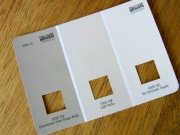Why Your Wall Paint Color
May Look Weird
Puzzled about why your wall paint color looks weird? Consider the possible reasons below - they may hold the key to the mystery!
Finished painting your room but disappointed that the wall paint color didn't turn out the way you expected? You are not the first one who had this frustrating experience with interior wall colors - if that will make you feel better.
Interior paint colors can act up for many reasons. And while you may still have to repaint in order to solve the existing color problem, knowing these reasons will prevent you from making the same mistake again.
Lighting is playing tricks with your wall colors

Even if you've done a great job choosing the right paint color for the room, natural and artificial lighting often has a final say in how the color will look on the walls.
Different sources of light affect colors differently - some will enhance certain paint colors, others will dull colors or even wash them out. It's not uncommon for lighting to change a color altogether. Learn more about how light affects color and what you can do about it in the tutorial "Interior Wall Paint Colors and Light".
Another color is being reflected on the walls

Sometimes it's the reflection of another color that is the culprit. The source of reflection may be mirrors, shiny/laquered furniture and floors, or other objects in the room.
In a room with an accent wall, the color of the feature wall may affect or be affected by the adjoing walls - that is especially noticeable with bold, high contrasting colors.
Likewise, a bright green lawn or evergreens in front of your window may be casting a greenish light and altering the appearance of the room paint color.
Undercoat is showing through and affecting the new paint color

When going for a dramatic wall color change (e.g. from white to blue, or from green to red, etc.), pre-painting surface preparation is essential. You need to use the right kind of primer first - white primer when going from dark paint colors to light ones, and tinted/gray primer when painting a deep color over a very different color or over a light shade.
Not using enough coats is another possibility why the color is looking funny.
Mistake in the paint color formula

This can happen sometimes - the color mixing equipment is due for a tune-up, or the paint store clerk makes a mistake. The chances are higher if you are trying to custom match a wall paint color to a piece of fabric, existing paint color, etc. The scanner may not pick up the undertone correctly, and the difference will reveal itself only after the walls are painted.
You didn't follow the process for choosing paint color

Choosing the right paint color involves many steps - from learning how to see color undertones, to finding the right shade, to matching paint color, to testing it properly and so on.
Sure, it takes some work on your part, but it also minimizes your chances for disappointment and unpleasant surprises.









Leave a Comment: